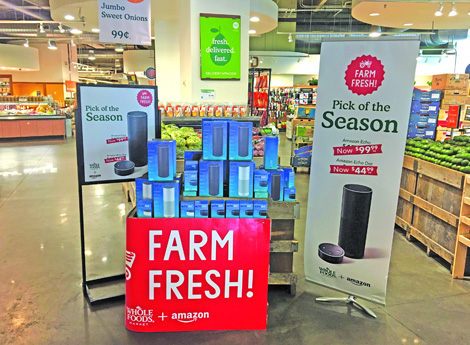 NEW YORK: Amazon's Echo and Echo Dot appear on sale at a Whole Foods Market in New York yesterday. - AP
NEW YORK: Amazon's Echo and Echo Dot appear on sale at a Whole Foods Market in New York yesterday. - APNEW YORK: Amazon completed its $13.7 billion takeover of organic grocer Whole Foods yesterday, taking quick aim at the chain's "Whole Paycheck" image and bringing it in line with Amazon's practice of keeping prices low to lock in customer loyalty. Beyond lowering prices on organic avocados, eggs and kale, it also means Whole Foods brands will be available on Amazon's site. The company aims to make Amazon Prime the rewards program for Whole Foods customers, and offer members special discounts. The deal could also spur big changes in how people shop for groceries.
In Amazon's first official day running Whole Foods yesterday, the online giant slashed some food prices. Almond butter went from $7.99 to $6.99 a jar. Organic Fuji apples went from $3.49 to $1.99 per pound. Organic rotisserie chickens went from $13.99 to $9.99 each. A dozen organic eggs now cost $3.99 instead of $4.29. The list goes on and also includes organic avocados, butter, salmon, and tilapia.
While the new price cuts aren't about to lose Whole Foods its "Whole Paycheck" moniker anytime soon, they make the cost of shopping there a bit - and only a very little bit - less prohibitive. In addition to lowering prices on foodstuffs, Amazon seems to be running another sale, the "pick of the season," at its new grocery chain. Here's what you need to know:
What Amazon wants from whole foods
It gives Amazon more than 465 physical stores in the US, Canada and the UK. Before the acquisition, Amazon had a small brick-and-mortar presence with less than a dozen bookstores, a prototype convenience store in Seattle and pickup locations in some cities near college campuses. The tie-up may also give the Seattle-based company valuable data on how people shop in stores, where the vast majority of retail sales still take place. Amazon is an expert in using data on past purchases and browsing to offer suggestions that might make people buy more, and could start applying that in stores as well as online.
Whole Foods, meanwhile, gets to exhale. Before the deal, the chain was under intense pressure from shareholders to improve its financial results and figure out how to stop customers from going to lower-priced supermarkets to buy natural foods. Whole Foods CEO John Mackey, who will stay in that role, said Amazon's history of innovation could transform Whole Foods from "the class dunce" to "valedictorian."
What will change for shoppers
Amazon already lowered prices at Whole Foods yesterday on a range of kitchen staples, including ground beef and rotisserie chicken. Whole Foods was just starting to test a loyalty program. But soon, shoppers at all stores will be able to tap Amazon's $99-a-year Prime loyalty program to get discounts at stores. And they will eventually be able to buy some Whole Foods products from Amazon.com. Lockers will be added in some locations so Amazon shoppers can pick up e-commerce orders or return items they don't want.
Amazon said more changes are coming, but didn't give details. Those that watch the industry expect it to push further into grocery deliveries, among other things. Whole Foods stores can serve as new distribution points for the AmazonFresh delivery service, allowing Amazon to expand where it offers home deliveries. That could include an expansion of ready-to-cook meal packages it's been testing in selected markets, including Seattle.
What it means for the competition
Shares of supermarkets took a hit when the deal was announced in June, and again when Amazon said last week that it planned to cut prices at Whole Foods. Rivals are scrambling to keep up: Kroger is testing online grocery delivery in several cities. And Walmart, the nation's largest grocer, is expanding its online grocery ordering and store-curb pickup to more stores. Last week, Walmart said it is joining forces with Google to let customers order goods with their voice on Google-run smartphones and other devices.
How the deal went through
Despite Amazon's dominance online, Walmart remains the leading retailer overall, with more than three times Amazon's retail revenue. A union that represents food-industry workers had asked the Federal Trade Commission to examine the deal carefully, saying it could hurt competition, but the US regulator didn't see it that way.
The FTC said last week that it conducted an investigation to see if the acquisition lessened competition and "decided not to pursue" the matter. Typically, deals that bring two direct competitors together raise flags with regulators, but Amazon - despite its online dominance - doesn't currently have a big groceries business. - AP










